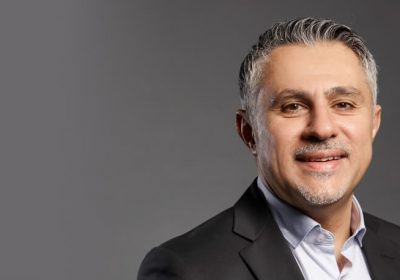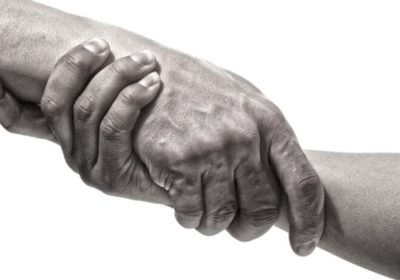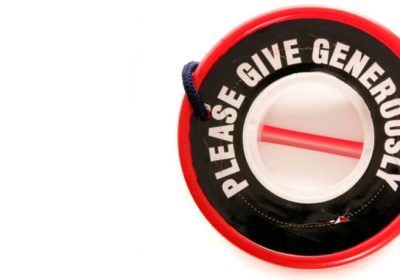
- Author: Tom Smith
- Posted: January 31, 2021
The CFO Giving Clothing a Second Life
By George Hazim
Photo: Luis Ascui, Media Culture
Clothing bins play a critical role in boosting Australia’s low textile recycling rate – progressing towards a thriving global circular economy.
For Australians, they are conspicuous by their presence – visible ghosts sitting obtrusively while undertaking a job many of us have little understanding or take for granted.
Yet there is a purpose for their presence – Australians contribute daily to a sustainable economy through their generosity that has never really been fully recognised nor appreciated.
Each year, thousands of tonnes of unwanted clothes are dumped into landfill – clothes carelessly wasted, along with the resources used to make them.
There is undoubtedly an oversupply of Australia’s unwanted clothing in the second-hand clothing sector, more than is needed to cloth Australia’s disadvantaged and to fill our charity and opportunity stores.
Oversupply for many years has come with its challenges, those challenges have seen Melbourne social entrepreneur Chris Todorovski, help redirect the industry towards hope, reform and prosperity.
Todorovski identified a glaring deficiency in the reuse and recycling of second-hand clothing to deal with oversupply and its pollution of landfill.
Reuse and recycling of clothing was a baron less industry until he saw the need to redefine what happens with unwanted clothes.
Historically, when many charities were overstocked with generous public donations, the oversupply was often sent to landfill.
As a former employee of the sector, Todorovski realised charities were losing money rapidly and by using this model, he implemented a sustainable supply chain management system.
Second-hand clothing oversupply is now purchased off charities, generating an income from excess donations and these items are then redistributed ethically to developing communities throughout the world.
SCRgroup operated by The Todorovski family sees son-in-law Andre Samo as its Head of Finance and Operations and Todorovski’s daughter Alexis as its Head of Business Development and Communications.
Their unique model sees at least 96% of what they collect diverted from landfill, where 70% is sorted for reuse with the remaining 30% recycled into rags or converted into a biofuel.
The company seeks to further extend its influence of sustainability by investing in emerging global fibre to fibre recycling technologies and other advancements in their space.
Samo an ex-PwC executive, built much of his status through his strategic expertise in PwC New York’s Asset & Wealth Management team specialising in private equity real estate investments and debt funds.
Undertaking the project Samo says, is a challenge, a challenge he thinks is more than achievable.
“The company’s objective has long been to ensure clothing can be repurposed and if not, recycled in an economically sustainable manner. That’s the very nature of our business – forging greater sustainability and prosperity for those in need.”
“We are developing numerous programs that not only educate the public about what to do with their clothes, but how we can continue to successfully work with our social organisations and local government as well as work with our global networks to ensure our discarded items are given a second chance by those who need it most.”
According to Samo, much of the work around education and research programs is because of the outstanding work of the passionate and committed team at SCR to establish a range of market leading initiatives.
Samo says, the team at SCRgroup have established:
- Thread:collect – a FREE clothing home pickup service that is quickly expanding in local Government and is becoming more popular as it’s a convenient, contactless and COVID safe option for clothing collection.
- Recycle with Mondo/Sustainable Students – Fundraising and education programs like for primary and secondary students that teach future generations of the importance of clothing reuse and recycling, sustainable behaviours and the impact textile sustainability has on our environment.
- Street collections – SCRgroup services more than 1,500 clothing hubs around the country. SCRgroup has recently redesigned the traditional piece of infrastructure to reflect today’s current culture and trends and called it the Feelgood Hub, which is on display at Australia’s fifth largest shopping centre, Highpoint located in Maribrynong Melbourne. The Feelgood hub is now beginning to roll out at most major shopping centres.
- Pop-up trailers – Similar to a clothing hub, these pop-up boxes are offered to service densely populated areas in partnership with local Government. They provide temporary drop-off points for spaces where permanent locations for clothing hubs may not be available.
- Pop-up reuse and recycling days – SCRgroup offers half day events in partnership with local Government for residents to drive-thru and drop-off larger unwanted household items such as furniture for FREE.
- Clothing take-back programs – Offered to retailers to promote instore sustainability initiatives such as shoppers swapping their preloved clothing for a voucher. SCRgroup can also provide solutions for aged and faulty stock.
- Uniform recycling – SCRgroup has recently expanded into the uniform recycling space, providing one of the only ethical solutions for uniform recycling in Australia that safely destructs logos and prevents materials from going direct to landfill.
Overseeing SCRgroup’s financial and strategic operations, Samo has been charged with firming up its work with Australian Charities and its strategic recycling policy.
SCRgroup’s objective is to educate and implement programs that deliver on outcomes of change and sustainability while improving on the lives of those who need it most.
“SCRgroup,” he says, “has transformed the market in many ways, with the programs it has introduced. We’ve led the industry through the investment we make in user research, analysis and industry trends.”
“How we will work in the future to ensure the success of our programs will be to lead a market-collaborate approach to ensure innovative solutions are environmentally and economically sustainable and resilient.” Samo says.
What that means according to Samo, is to encourage the industry and consumers to not only think about where they want their preloved clothing to go after they have finished wearing them, but to also consider sustainability of supply chains.
“There are plenty of options available to them including dropping their clothes off to their favourite charity store, finding their nearest SCRgroup clothing hub on our website (www.scrg.com.au/hub-finder) or subscribing to any of other programs, either via our website or by contacting their Council.”
Australia has a textile recycling rate of 12%, compared to the US who is at 14.7% and Germany at 75%.
“By combining all that we are doing, the programs we have developed and strategizing on how we work with our stakeholders collaboratively, there is every chance our strategy will succeed,” Samo says.
SCRgroup recently lodged a written a submission to a Parliamentary Inquiry into Australia’s Waste Management and Recycling. SCRgroup recommended Australia adopt similar policies as in Europe to achieve higher recycling rates and more regulated sustainability processes.
In 1975, the European Parliament introduced its Waste Framework Directive with a long-term goal of transforming Europe into a resource efficient society with maximum recycling of waste, waste generation reduction and using waste as a valuable resource where possible.
France is the only country globally implementing an EPR policy for end-of-use clothing, linen and shoes, highlighting the benefits of using an EPR policy and provides interesting insights about the challenges faced by the textiles waste sector.
Such an EPR policy also could drive societies to financially support innovation and research to provide feasible solutions for fashion producers to adopt eco-design and design for recycling practices. According to Samo, some governments are receptive, and some are not.
“There is an inconsistency in the approaches of both State and Federal Government approaches to textile sustainability and providing residents with ample opportunity to dispose of unwanted clothing in an ethical, environmentally friendly way.”
“More work and consideration by Government is needed because they have a definite role to play here,” Alexis Todorovski says.
Todorovski says, “The time has come where we all conscious of the role we play to ensure the clothing we once loved is given a chance to be loved again but recycled with purpose and not ending up in landfill.”








